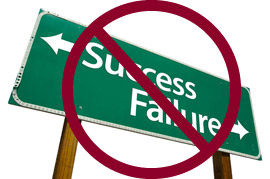Failure is a part of business as much as it is a part of life. You can’t avoid it entirely, but you can use disappointments to your advantage if you’re willing to approach them differently. As Samuel Beckett once said, we need to learn to fail better.
When something doesn’t go as we hoped, it’s tempting to throw up our hands, grab at the first available explanation, and submit to defeat. But business success is partly about cultivating failures, using them to find a winning formula. How you tackle problems and disappointments will in large part determine the outcome of your business. There’s a telling gap between deciding that “It’ll never work” and saying to yourself, “Huh, that didn’t work. Okay, then, what’s my plan?”
Look at the big picture
The first step is teaching yourself to see the big picture. Research shows that we humans are inept at big-picture thinking. We tend to be swayed by the current moment’s impressions. We feel business is thriving when we’ve recently added a couple of new clients, and are convinced we’re going to crash and burn when a day or two go by without a call. To avoid this emotional roller coaster, track data so you know what’s really happening. Whether or not you got calls today is less important than whether the number of calls this month indicates growth, particularly from the same month last year. When you’re feeling down, let the data give you a reality check. Are you really failing or just having a slow week?
Be patient
Patience plays an important role in assessing failure and success. In our business consulting work we sometimes see a tendency to give up too soon. But success takes time. When you’re in start-up mode or launching a new service or attempting to grow, you can’t measure results in weeks or even, in most cases, a few months. A new marketing push can easily take six months or more to show results. And a new service takes time to catch on.
If you get edgy too soon, it’s easy to make knee-jerk decisions like lowering rates or ending an “unsuccessful” marketing project—exactly the kinds of decisions that can cause the failure we fear. You want such decisions to be based on the big-picture data instead of immediate, emotion-fueled impressions.
Assess your failures
Before you give up on something, assess your perceived failure and create a plan of action. Ask yourself:
1. What was my original goal for this service/ marketing project/ business, etc? (If you can’t answer this question, that could be part of the problem. Always plan your endeavors around a set of goals to give you a strong basis for your decision making.)
2. What evidence is there of success? Of failure?
3. What have I done so far to promote success for this goal?
4. What are my hypotheses about why it is or isn’t working? And what evidence do I have for these?
5. What are my options for action? How do each of these options support my original goals for this project, and/or my general business goals and how I want to be perceived by potential clients?
Take action
Looking at your answers to these questions, decide what you’ll do. Is it time to tweak the original project? Time to increase your marketing efforts? Sit tight and give it a bit more time? Always take these options seriously before considering scrapping an idea. And if it really is time to let a project go, turn your attention immediately to the next one. What have you learned from this failure to help your next endeavor meet with success?
Failure doesn’t have to carry the negative connotations we associate with it. It should be something to be expected. Not in a fatalistic, “this will never work” way, but just as a natural part of risk taking, of living. Learning to embrace failure as a stepping stone to success not only leads to that success—it also makes getting there a whole lot more comfortable.


